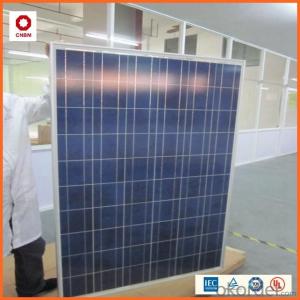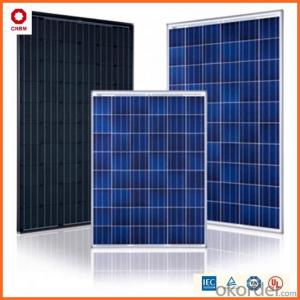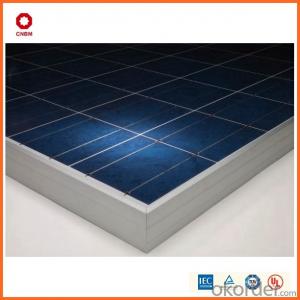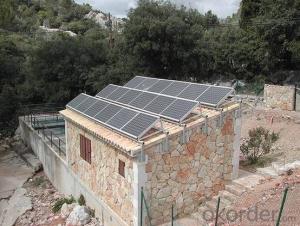40w Small Solar Panels with Good Quality
- Loading Port:
- China main port
- Payment Terms:
- TT OR LC
- Min Order Qty:
- 1 watt
- Supply Capability:
- 10000000 watt/month
OKorder Service Pledge
OKorder Financial Service
You Might Also Like
Item specifice
Hot Sale !!! Quality and Safety of Small Poly Solar Panel 25~85w
1. Rigorous quality control meets the highest international standards.
2. High-transmissivity low-iron tempered glass, strong aluminium frame.
3. Using UV-resistant silicon.
4. IS09001/14001/CE/TUV/UL
Warranties of Small Poly Solar Panel 25~85w
1. 10 years limited product warranty
2. 15 years at 90% of the minimal rated power output
3. 25 years at 80% of the minimal rated power output
Specification
Characteristics of Poly solar panels CNBM (25-85W) | |||||
Max Power Voltage Vmp(V) | 30.3 | 30.8 | 31.1 | 31.4 | 31.85 |
Max Power Current Imp(A) | 7.60 | 7.64 | 7.73 | 7.81 | 7.85 |
Open Circuit Voltage Voc(V) | 36.1 | 36.6 | 37 | 37.3 | 37.68 |
Short Circuit Current Isc(A) | 8.50 | 8.55 | 8.65 | 8.75 | 8.85 |
Max Power Pm(W) | 230W | 235W | 240W | 245W | 250W |
Temperature Coefficient of Cells Poly solar panels CNBM (25-85W) | |
NOCT | 45± 2 |
Temperature Coeffucients of Isc | 0.0492 |
Temperature Coeffucients of Voc | -0.3374 |
Temperature Coeffucients of Voc | -0.4677 |
Mechanical Data of Poly solar panels CNBM (25-85W) | |
Dimension | 1638 × 982 × 40 mm |
Weight | 19.5 kg |
No. of Cells and Connections | 60 (6 ×10) |
Tolerance | 0 ~ + 5 W |
Cell | Monocrystalline Cell 156 × 156 mm |
Packing | 624 Pcs/40ft(H) Container |
Limits of Poly solar panels CNBM (25-85W) | |
Operating Temperature | -40 to +85 |
Storage Temperature | -40 to +85 |
Max System Voltage | 1000VDC(IEC) / 600VDC(UL) |
Features of our products:
• High conversion efficiency mono/poly-crystalline amorphous silicon solar cells
• Modules incorporate high performance bypass diodes to minimize the power drop caused by shading
• High transmittance, low-iron tempered glass
• High performance EVA encapsulant to prevent destroying and water.
• AI frame: without screw, corner connection. 8 holes on the frame can be installed easily
• Good performance of preventing from atrocious weather such as wind and hails
• Certifications: CE IEC TUV VDE UL, Class I
• 10 years 90% power output warranty

Shipping of Small Poly Solar Panel 25~85w
By Sea | Delivery from Shanghai or Ningbo seaport |
By Air | Departure from Shanghai Pudong Airport |
By Express | Post by DHL, EMS, UPS, TNT. |
- Q:What is the impact of dust storms on solar panel efficiency?
- Dust storms have a negative impact on solar panel efficiency as they can obstruct sunlight from reaching the panels, reducing their overall power output. The accumulation of dust particles on the surface of the panels can also create a layer that hinders the absorption of sunlight, further diminishing their efficiency. Regular cleaning and maintenance of solar panels are essential to mitigate the effects of dust storms and ensure optimal performance.
- Q:Are solar panels weather resistant?
- Yes, solar panels are designed to be weather resistant. They are built to withstand various weather conditions including rain, snow, wind, and extreme temperatures. The materials used in their construction are durable and can protect the panels from damage caused by weather elements. Additionally, solar panels are tested and certified to meet industry standards for weather resistance.
- Q:Can solar energy systems be used for powering electric vehicle testing tracks?
- Yes, solar energy systems can be used for powering electric vehicle testing tracks. Solar panels can be installed alongside the track or on nearby structures to generate electricity. This renewable energy source can then be used to power the charging stations for electric vehicles, providing a sustainable and environmentally friendly solution for testing tracks.
- Q:Can solar energy systems be used in areas with high levels of dust or debris?
- Yes, solar energy systems can be used in areas with high levels of dust or debris. However, regular maintenance and cleaning may be required to ensure optimal performance of the solar panels.
- Q:How does the size of a solar energy system affect its cost?
- The cost of a solar energy system is influenced by its size. In general, the larger the system, the more it will cost. Several factors determine the cost, including the number of solar panels, the type and quality of the panels, the capacity of the inverter, the mounting equipment, and the labor required for installation. The number of solar panels is a crucial factor in calculating the cost. Solar panels are the primary source of energy generation in a solar system. The more panels you install, the more energy the system will produce. However, each additional panel adds to the overall cost, including the cost of the panel itself, the additional wiring, the mounting hardware, and the labor needed for installation. Another factor to consider is the type and quality of the solar panels. Different panels have varying efficiencies, durability, and warranties. Higher-quality panels with better efficiency are typically more expensive. However, they often come with longer warranties and can generate more electricity over their lifespan, resulting in greater overall savings. The capacity of the inverter is also important in determining the cost. Inverters convert the direct current from the solar panels into alternating current that can be used to power household appliances. Larger solar systems usually require larger inverters to handle the increased energy production. Higher capacity inverters come at a higher cost, which contributes to the overall system cost. The cost is also affected by the mounting equipment and labor required for installation. Larger systems may require more mounting equipment, such as racks and brackets, to securely hold the solar panels. Furthermore, the labor cost for installation increases with the system's size because it takes more time and effort to install a larger number of panels. It is worth noting that although a larger solar energy system may have a higher upfront cost, it can lead to greater long-term savings by reducing electricity bills. A larger system generates more electricity, potentially offsetting a greater portion of your energy needs and reducing your reliance on grid electricity. In conclusion, the size of a solar energy system directly influences its cost. The number of panels, type and quality of panels, inverter capacity, mounting equipment, and installation labor all contribute to the overall cost. It is crucial to carefully consider your energy needs and budget when determining the appropriate size of a solar energy system for your specific requirements.
- Q:Can solar energy systems be used in areas with limited access to maintenance services?
- Yes, solar energy systems can be used in areas with limited access to maintenance services. Solar panels are highly durable and require minimal maintenance. They have no moving parts that can break down easily and need occasional cleaning to remove dust or debris. Additionally, advancements in solar technology have made systems more reliable and resistant to harsh environmental conditions. With proper installation and occasional cleaning, solar energy systems can operate efficiently for many years, making them suitable for areas with limited maintenance services.
- Q:What are the different incentives available for installing solar energy systems?
- There are several incentives available for installing solar energy systems. These include federal tax credits, state and local incentives, net metering programs, solar renewable energy certificates, and grants or loans for renewable energy projects. These incentives help to reduce the upfront costs of installing solar panels and make solar energy more affordable for homeowners and businesses.
- Q:Can solar energy systems be used for powering off-grid space exploration missions?
- Yes, solar energy systems can be used for powering off-grid space exploration missions. Solar panels can capture sunlight and convert it into electricity, providing a reliable and sustainable source of power for various systems and equipment used in space missions. This reduces the need for traditional fuel-based generators and can significantly extend the mission duration and capabilities in remote and off-grid locations.
- Q:Can solar energy systems be used in commercial or industrial applications?
- Yes, solar energy systems can definitely be used in commercial or industrial applications. In fact, many businesses and industries around the world are increasingly adopting solar energy systems to power their operations. These systems can be installed on rooftops, parking lots, or ground-mounted, providing a reliable and sustainable source of electricity. Not only does solar energy help businesses reduce their carbon footprint and lower their energy costs, but it also provides them with long-term energy independence and resilience.
- Q:How does the quality of solar panels vary based on the manufacturer?
- The quality of solar panels can vary significantly based on the manufacturer. Different manufacturers use varying materials, manufacturing processes, and quality control measures, which can all impact the performance, durability, and efficiency of the panels. Reputable manufacturers often invest in research and development to improve the technology, resulting in higher quality panels that are more efficient, have longer lifespans, and offer better warranties. Cheaper or lesser-known manufacturers may cut corners, resulting in lower quality panels that may not perform as well or last as long. Therefore, it is crucial to choose solar panels from trusted and experienced manufacturers to ensure better quality and performance.
1. Manufacturer Overview |
|
|---|---|
| Location | |
| Year Established | |
| Annual Output Value | |
| Main Markets | |
| Company Certifications | |
2. Manufacturer Certificates |
|
|---|---|
| a) Certification Name | |
| Range | |
| Reference | |
| Validity Period | |
3. Manufacturer Capability |
|
|---|---|
| a)Trade Capacity | |
| Nearest Port | |
| Export Percentage | |
| No.of Employees in Trade Department | |
| Language Spoken: | |
| b)Factory Information | |
| Factory Size: | |
| No. of Production Lines | |
| Contract Manufacturing | |
| Product Price Range | |
Send your message to us
40w Small Solar Panels with Good Quality
- Loading Port:
- China main port
- Payment Terms:
- TT OR LC
- Min Order Qty:
- 1 watt
- Supply Capability:
- 10000000 watt/month
OKorder Service Pledge
OKorder Financial Service
Similar products
New products
Hot products
Hot Searches
Related keywords































